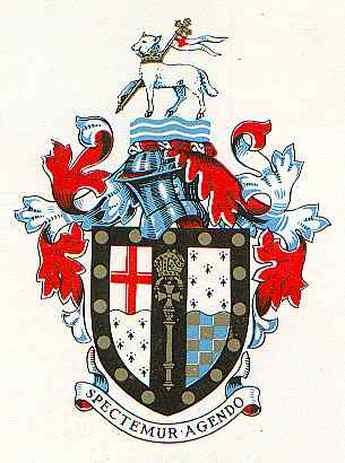
The actual Norman conquest which followed the Battle of Hastings occurred in a piecemeal fashion. This is suggested by the similarity between the Coats of Arms of certain cities and towns in widely disparate parts of England. For example, the gold and blue checkers of the Warrennes, Earls of Surrey appear in the shields of places ranging from Lewes (arms above) to Dewsbury and including Lambeth. This indicates not only the possessions granted by the Duke of Normandy to William de Warrenne, ancestor of the checker-bearing family, but also the scattered nature of their territory, and indirectly the manner in which Duke William distributed the spoils of his conquest. Faced with a clamorous demand for land by a host of adventurers, he parceled out the country as he won it, granting first small parcels and later more substantial tracts of land. The fortunate but not necessarily premeditated result of this enforced policy was that the Duke prevented his followers obtaining large tracts of land in one district, and setting themselves up as serious rivals to his monarchy.

LAMBETH ARMS
.
Only in the key counties on the border of his realm, Durham, Chester, Shropshire and Kent, did William permit great semi-independent jurisdictions to arise. The mitre of the See of Durham, plumed like a helmet and with a coronet about its rim, is symbolic of the palatinate jurisdiction which William conferred upon that bishopric, the patrimony of St. Cuthbert, which “lay as a sacred boundary between England and Scotland.” The seal of Lord Crewe, a seventeenth-century Bishop of Durham, contained the figure of a fully armed man on horseback, his warlike appearance being palliated by an inscription suggesting his Arms to be of a spiritual nature: Propterea accipite armaturam Dei galeam salutis assumite et gladium spiritus. But the seal clearly referred to the soldierly character of the old-time bishops. The Palatinate was transferred to the Crown in 1836, but the Bishop of Durham still retains the coronet about his mitre.
The presence of two gold lions on red (the supposed Arms of the conqueror) in the shield of the See of Lincoln commemorates the ecclesiastical reorganization undertaken by Duke William and Lanfranc, which resulted in the transfer of the center of the vast northern bishopric from Dorchester-on-Thames to Lincoln. Pevensey, which was granted to Gilbert de Aquila and came to be known as the Honor of the Eagle, still uses as Arms a red eagle upon gold in allusion to the Norman family de Aquila.



